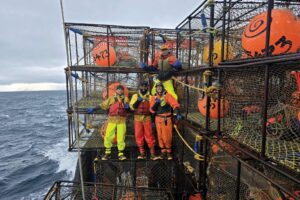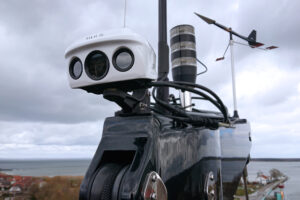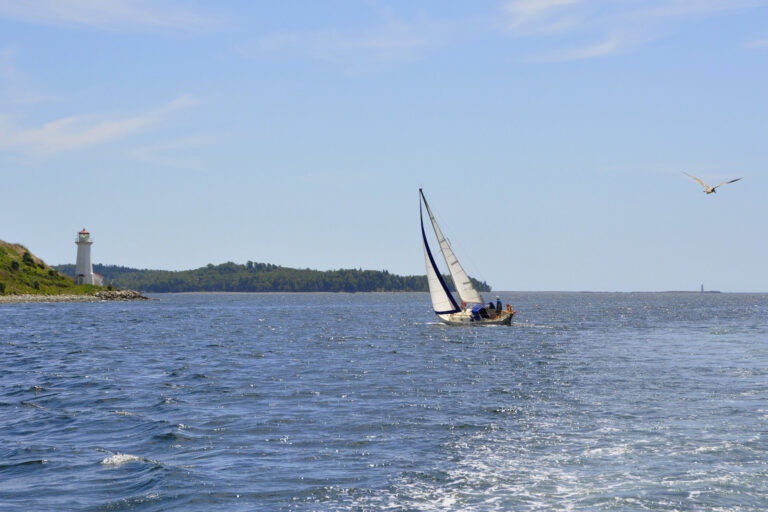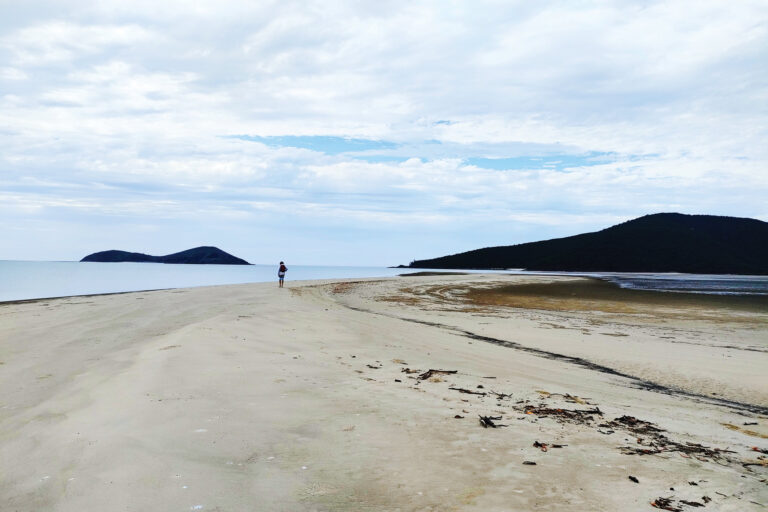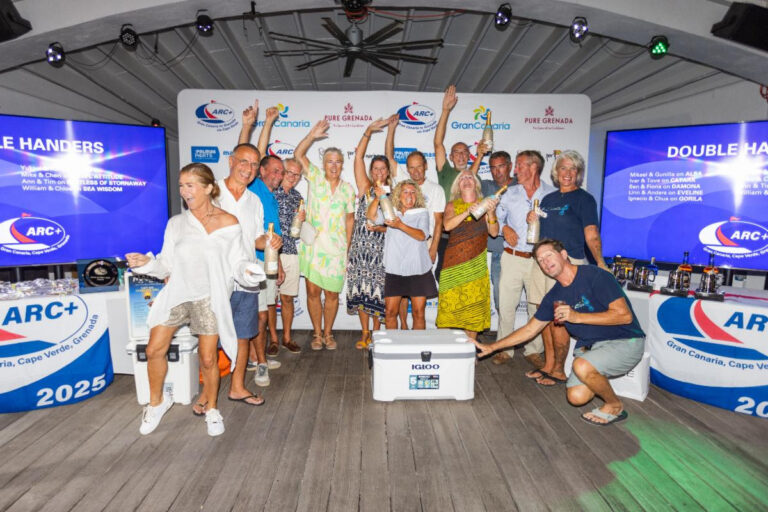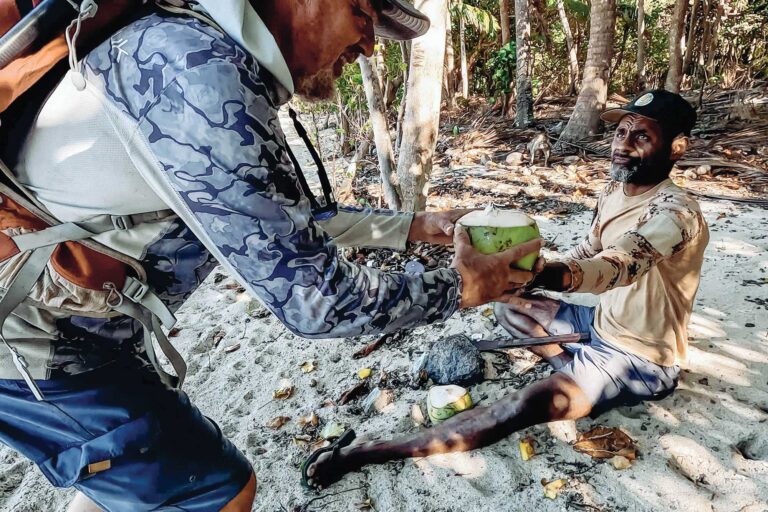|

After a full day of climbing into, out of, over, and under a string of new life rafts, I couldn’t decide if it was my jump off the boat or the jump that followed mine that gave me the most pause for thought. The first came about as I stood amidships on Little Wing, the Passport 40 we’d borrowed for the day. It was August in Rhode Island, and I wore my foul-weather jacket and had a life jacket zipped tightly around me. Three feet below and a couple of feet from the deck, the gaping mouth of a Winslow ISO Global Star six-person life raft awaited me and my three colleagues lined up along the rail.
Streaming out behind us were seven more life rafts (a ninth was tested on another day), representative of the latest generation of safety equipment being built to standards now mandated by some offshore-racing and rally organizers. While we weren’t conducting a formal test, the CW editorial team had decided to review the features of each raft, spend some time using them, then pass along our findings to readers to help you consider the many options available.
No time being like the present, I stepped to the lifelines and made the leap. As I landed and slipped quickly to my knees, I felt cold water rush around my legs and up my coat as I scurried out of the entranceway. I’d always wondered how it would feel to abandon ship, and though this was but a drill, that first step from a solid deck to a watery, bouncy raft had been, well, different.
Then came the second jump. With a dull thud, heavy boat shoes hit the life raft’s floor. They came in fast and threatening. The floor pitched, and Doug Ritter, executive director of Equipped to Survive, tumbled into me as he slid out of the doorway and off to the side to make way for the others. Quickly, our consultant on this project, Steve Callahan, the author of Adrift, the chronicle of his 76 days in a raft crossing the Atlantic, and CW managing editor Elaine Lembo followed, with knees and elbows flying. And then there were four of us under the fabric canopy, sizing up the space and imagining what it would be like if we were really calling this home until rescuers arrived, what boarding might have been like if it were taking place at night and in heaving seas, and, most important, how easy, even in these controlled conditions, it would be for someone to be injured-when jumping or when being jumped upon-and for serious complications to quickly set in. Elaine, in fact, was about to get a too-real taste of trouble as we went through our planned assessment drill.
By day’s end, once we’d finished going through the inventory of safety equipment stored aboard each raft, Steve would conclude that, as with most things relating to boats, a lot of compromises had to be made on how each raft was designed, built, and equipped. As a group, we found notable variations in comfort, kit, and construction, but we also agreed that should we find ourselves on a sinking boat far from shore, we’d be pretty relieved to step aboard any of the rafts that we’d looked at.
First though, we had to put these puppies through their paces. As those aboard Little Wing let out our painter, we were pushed backward by the current that in a minute would make it hard for us to swim about in our foul-weather gear, life jackets, and other clothing. One by one we jumped into the water, then used the Winslow’s inflatable ramp and ladderlike webbing that runs across the raft’s interior to pull ourselves back aboard-a maneuver that took a surprising amount of upper-body strength and defied a graceful execution. Then we crowded to one side of the raft, used the strings hanging from the bottom to empty its ballast bags, and flipped it over, taking to the water again. We decided that Elaine, the smallest and lightest, would use the strap across the bottom of the raft to climb up its side and right it. It was hard work and took her a few tries, but soon the raft slowly rose and rolled back onto its bottom-landing on top of a disoriented Elaine. Though she was at the edge of the circular raft, her life jacket and wetsuit pushed her upward and into the floor. Quickly, Steve Callahan sized up the problem and pulled her, sputtering, free. Yes, these rafts are a serious business.
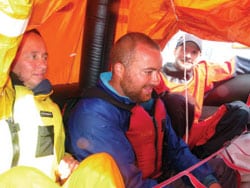
Gretchen Thor| |With 4 square feet per person, even a six-person raft is “cozy” when Sue Pillsbury (left), Mike Lovett, Steve Callahan, and a photographer are aboard.|
A Comparison of Features
After consulting on the latest industry trends with Jim and Dan O’Connor, who run Life Raft & Survival Equipment, based in Portsmouth, Rhode Island, Cruising World editors decided to take a look at some of the new life rafts being built to standards drafted by the International Organization for Standardization and the International Sailing Federation, commonly referred to respectively as ISO and ISAF. (See “A Discussion of Life-Raft Standards,” page 64.) These rafts are required aboard sailboats participating in certain offshore-racing events, and often such requirements trickle down to cruiser-based rallies, such as the Atlantic Rally for Cruisers, which now mandates a life raft meeting International Convention for the Safety of Life at Sea (SOLAS), ISAF, or ISO 9650 guidelines. It’s likely, we felt, that this new generation of rafts could create a buzz at boat shows when customers inquire about new products.
The manufacturers that participated in our review included DSB, Revere Survival Products (the sole raft in our study that isn’t built to a particular set of standards but is intended for offshore work), Switlik Parachute Company, Viking Life-Saving Equipment, Winslow Life Raft Company, and Zodiac. In a separate session, we also took a look at a raft that Zodiac builds to specifications developed by West Marine.
Both manufacturers and safety experts on hand for our session were quick to point out that while there are valuable features in these standards-based rafts, there are some tradeoffs, too, primarily because these rafts tend to be heavier and more expensive. Unless one is planning to sail in an offshore race or rally, there may be no need to upgrade from your old raft or pay a premium for one of the models we looked at.
What was clear as the rafts were inflated, one after the other, is that there are a lot of variations to consider. Such factors as raft shape, tube construction, canopy height, floor insulation, door size, and ventilation can have a pronounced effect on comfort and performance offshore. Round rafts are thought perhaps to be more stable, rectangular ones more comfortable for stretching out, and high canopies may make it easier for tall people to sit up for long periods. But stability also depends to a large degree on the form and function of the raft’s ballast bags, while a high canopy that allows for headroom will increase windage, meaning you may drift farther afield from where your EPIRB initially signaled. Of course, if the emergency signal stopped broadcasting, that increased windage might help you drift to shore faster, too.
On the Water
To get a look at the rafts, we launched most from a dock, but we saved one packed in a valise and one in a canister to deploy from the deck of Little Wing. Our learning curve began as we carried each raft down the dock to be thrown off. Those packed in hard-shell canisters, which outweigh valises by about 10 pounds, were heavy, and almost all were hard to grip. On a pitching deck, it would be tough work for a shorthanded crew to move one of these about. That said, most canisters sit in a deck-mounted bracket and wouldn’t need to be moved far to reach the rail. Still, some straps or handholds are needed; one offered only a fingertip grip where the two halves of the canister came together. The valises, with their hand straps, were much easier to handle, thought it was tough to imagine lugging one up from below in less than 15 seconds, which is one of the safety criteria cited by U.S. Sailing.
Once each raft was launched, the painter was tugged to fire off the inflating mechanism. Because rafts may be deployed in a wide range of temperatures, there’s extra gas in the inflation canister. We soon got used to the loud hiss of excess gas venting from the expansion valves. Callahan said that in the fury of an emergency, that hissing is often mistaken for a leak. But expansion valves are needed since pressure within the rafts’ tubes changes with temperature and must be allowed to vent.
With the launch of each raft, we witnessed many variations in features: inflatable boarding ramps, ladders made from webbing, fold-down fabric ramps, small doors, large doors, windows, observation hoods, and several different locations where painters might be attached. In the drills that would follow, we’d find that each variation had its pros and cons. Small doors make for good protection from the elements, but landing in such a hole when jumping aboard is harder. Webbing rungs designed for easy boarding can tangle legs. And a painter that keeps the door of the raft facing the opening in the lifelines can make boarding from the water all the more difficult.
To me, the biggest takeaway from this preliminary assessment was this: Whatever raft you buy, you’ll be well served to find an opportunity to become familiar with it before you need to use it on some dark night. Dealers and manufacturers either run training sessions or can point you to a third party so you can at least experiment with a similar model. Or better yet, when your raft is due for servicing, your repack station can open it with you in a controlled manner that won’t add wear and tear to the raft.
A Look at the Rafts
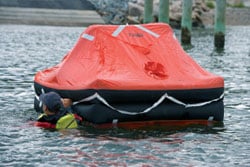
Gretchen Thor| |DSB ISAF Standard|
DSB ISAF Standard: DSB provided a pair of four-person rafts built to ISAF requirements, its ISAF Standard and its ISAF Ocean XR Self-Righting. The Standard, roughly rectangular in shape, comes packed in a valise. At 55 pounds, it’s the lightest we looked at. Inflated, the canopy has a generously sized opening on one side that uses a zipper and hook-and-loop fasteners to seal out the elements; there’s an observation hood, or inspection port, across from it. Outside the entrance, a fabric ramp folds down on webbing, with a web ladder underneath it so you can get a knee up when climbing in from the water. In general, we found it more difficult to climb aboard rafts with fabric rather than inflatable ramps.
The inner floors of both DSB rafts are made from insulated material (think cellular foam) with a surface that reflects heat back into the raft. On these rafts, the floors were attached to buttons in the corners, and both liners came loose as we moved about. We also found that the emergency equipment wasn’t adequately secured and tended to clutter the entranceway as we climbed aboard. Both rafts had conical sea drogues, some of the better we saw, made from a mesh material that would let water pass through.
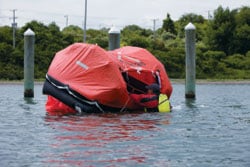
Gretchen Thor| |DSB ISAF Ocean XR Self-Righting|
DSB ISAF Ocean XR Self-Righting: Similar in shape to the Standard but with double arches, the self-righting ISAF Life Raft has an entrance on its longer side, which can be closed with a zipper and hook-and-loop fasteners, and a fold-down fabric entry ramp with webbing below. As in the Standard, there was a good ladderlike mesh of handholds running across the interior of the raft from the entryway, but unlike some rafts, this couldn’t be disconnected when everyone was aboard to get it out of the way. Once capsized, the raft needed only a little push to self-right; in waves it probably wouldn’t have needed help. While four could easily fit in either of the DSB rafts, quarters were tight, and all aboard concluded that if planning for a crew of four, a six-person raft would be worth the added expense. (DSB also manufactures 6-person rafts.) The extra space would also allow each crew to carry his or her own ditch bag, a practice recommended by safety experts. (Go to www.cruisingworld.com/1108ditch for more on ditch bags.)
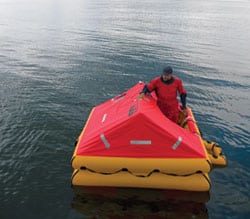
Gretchen Thor| |Revere Offshore Elite|
Revere Offshore Elite: The six-person raft from Revere is built for offshore sailing but not to ISO or ISAF standards. Packed in a valise, it weighs just 63 pounds, making it relatively easy to lift. Inflated, the raft is square, with an ample doorway and a large entrance ramp that inflates with the raft. The raft’s canopy is relatively low and brightly colored for visibility. There’s a quilted inner floor that can be inflated to aid in the prevention of hypothermia in colder water, and a zippered window across from the opening serves as an observation window and provides cross ventilation. The exterior of the raft is well marked with reflective tape, but we found that when launching the raft, it was difficult to find on the valise the black patch secured by hook-and-loop fasteners that peeled off to expose the painter. We also found that the features of the raft itself weren’t as well marked as on some of the other models. Although the raft comes with an older, parachute-style sea anchor, a bonus feature is that it automatically deploys when the raft inflates. On the raft we looked at, safety gear wasn’t tied down well and, as on several of the rafts we capsized, tended to get strewn about.
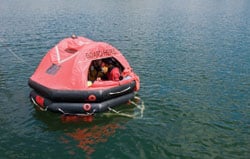
Gretchen Thor| |Switlik MD-3 International Offshore|
Switlik MD-3 International Offshore: The Switlik six-person raft is built to both ISO and ISAF standards and came packed in a valise with lots of handholds that made moving the 97-pound package more manageable. When inflated, the octagonal-shaped Switlik has ample entrances on two sides and clear observation windows on two other sides. There’s a fold-down fabric ramp, with web steps below, in front of one entrance and a web ladder at the other entrance. When boarding from the boat, the Switlik’s main opening can be easily held in front of the lifeline gate because the painter attaches to a triangular bridle anchored to either side of the boarding ramp. However, when a swimmer enters the raft from the water while the raft is still tethered to the boat, this bridle gets in the way and makes it difficult for the person in the water to get a knee in place on the ramp. We found that good handholds made the second entrance an effective alternative for a swimmer. Inside, we found the canopy was well supported and had good headroom, and both entrances featured zippers to seal out the elements.
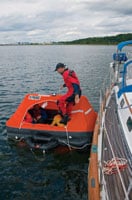
Gretchen Thor| |Viking RescYou|
Viking RescYou: Viking supplied two six-person rafts for our comparison, a standard model and a self-righting model; both are built to ISO and ISAF standards. The square-shaped RescYou standard raft was packed in a valise and weighs 77 pounds. Inflated, the tent-shaped canopy has one large opening whose flap can be sealed with a heavy-duty zipper; there’s an observation port/hood opposite for watchkeeping. At the entrance, there’s a rubber inflatable step with a webbing step that hangs beneath it. We found that this arrangement worked well when boarding from the water. The painter attaches to one corner of the raft, however, so we couldn’t hold the entrance square-on to the opening in the lifelines. The buoyancy tubes on both Vikings are made of two layers of natural rubber with a nylon core, which produces a tough, abrasion-resistant material. Inside both the rafts, the ladderlike handholds, made of webbing, can be untied and moved out of the way. We found well-secured gear bags in these rafts, with sea anchors lashed to them so the drogues could be found and deployed quickly after boarding, if needed. Moreover, Viking uses improved Icelandic-style drogues that have lines on their bridles so they can’t become tangled if they spin in the waves.
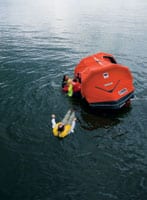
Gretchen Thor| |Viking RescYou Pro|
Viking RescYou Pro: The six-person self-righting raft we inflated came packed in a canister, which helped to make it one of the heavier we launched. The self-righting Pro model, rectangular in shape, has pointed ends that help increase buoyancy, and a well-supported arched canopy. Inflated, it has two large openings that can be sealed tight by flaps with heavy zippers. Like the standard RescYou, the Pro has an inflatable inner floor. All of the rafts we looked at rely on ballast bags that hang below the raft for stability. On several of them, it took two or three people leaning on one side to tip them over, but neither Viking could be tipped without a swimmer in the water to manually empty the ballast bags. Once up-ended, the Pro righted itself unassisted immediately, thanks to the large tubes that support the canopy.
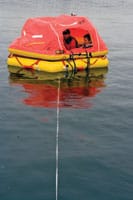
Gretchen Thor| |West Marine ISAF Bluewater|
West Marine ISAF Bluewater: The six-person Bluewater raft is built by Zodiac to West Marine’s specifications with a nylon and butyl rubber sandwich. The raft is hexagonal in shape, which combines with double arches to provide better headroom. The arched, bright-orange canopy has two openings, one with a large self-inflating boarding ramp, the other with a web ladder that extends well below the surface. Both worked well when boarding from the water. A valve in one of the canopy arches on the raft we tested was apparently not seated properly and leaked as we boarded the raft. Our attempt to reinflate the tube was at first successful, but subsequently the hose on the emergency pump broke, a good reminder of Callahan’s advice always to carry a spare pump in your personal ditch bag. Callahan also noted as a plus that the valve used also allows one to reinflate the tube by mouth, if need be. Safety equipment was well secured in the raft, and the gear bag contained a good array of items, including clamps of several sizes to repair the raft in an emergency. The raft has a black inflatable floor that can be pumped up to provide insulation in cold water.
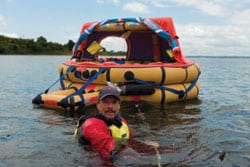
Gretchen Thor| |Winslow ISO Global Star|
Winslow ISO Global Star: The six-person Winslow raft, built to ISO standards, comes packed in a valise and weighs 99 pounds. Of all the rafts, this was the easiest to get into from the boat. Round in shape, it inflates with half of its canopy folded back, creating a large target to jump toward. The canopy can be fully removed for the tropics or zippered front and back to seal out the elements. Zippered windows can be opened for ventilation and for keeping a lookout. An inflatable ramp is found on one side of the raft and a web ladder on the other. We found that features and equipment are well marked; there’s no confusion about where to board, where to grip to right the raft, or what the function of a particular valve is. While the buoyancy bags on some of the rafts took some time to fill, Winslow has come up with a spring system that forces the bags to open and draw in water, so stability is quickly achieved after launching. The idea of internal ladderlike handholds made of webbing, which we saw in several of the rafts, was pioneered by Winslow, and in this raft, the ladder was easily removed with a clip. The Global Star comes packed with well-secured safety equipment, including a spare sea anchor. The primary sea anchor is self-deployed during inflation.
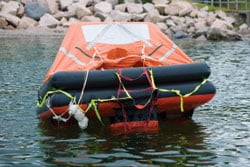
Gretchen Thor| |Zodiac Offshore ISAF|
Zodiac Offshore ISAF: At 95 pounds and packed in a canister, the Zodiac was one of the heavier rafts we launched, though moving it about was made somewhat easier thanks to carrying straps. We did find, though, that the canister, when lying flat and lifted, tended to quickly tip on its side. Inflated, the raft has a tent-shaped canopy and a fold-down fabric boarding ramp and good-sized entrances facing each other across the square-shaped craft. Inside, an aluminum-lined composite cellular foam floor acts as in insulator and reflects body heat back into the raft. The raft we looked at is used by Life Raft & Survival Equipment as a demonstrator and had seen multiple inflations, so we didn’t get a chance to inspect the ditch gear as supplied by the manufacturer. Company literature, however, indicates that it meets offshore ISAF requirements and is secured in a bag.
Mark Pillsbury is CW’s senior editor.



